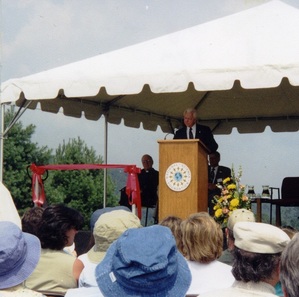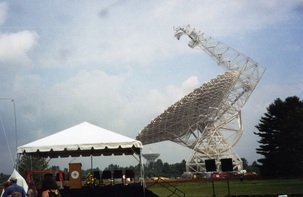|
Note: This post was previously listed under our "News from the Grey Box" blog series By Casey Dehaven On October 8, 2013, NPR aired a story entitled “Enter The Quiet Zone: Where Cell Service, Wi-Fi Are Banned.” This news item described two scientific installations in West Virginia: the Green Bank Telescope and the Sugar Grove research facility. Senator Byrd was instrumental in securing funding for these two sites, and we wanted to highlight his role in advancing the cause of science in his home state. In November 1988 in the foothills of Pocahontas County, West Virginia, the gusset plate, an integral piece of a structure’s anatomy, came loose and reduced the original Green Bank Telescope to a pile of rubble. Less than a year later, Senator Robert C. Byrd pushed a $75 million Emergency Supplemental Appropriation through Congress in order to secure federal funding to rebuild a more advanced model of the Green Bank Telescope in Green Bank, West Virginia. Construction of the telescope began in the summer of 1993; with Senator Byrd observing in one of his many Byrd’s Eye View columns that the “official operation of the new, technologically advanced National Radio Telescope is anticipated to begin in 1995.” He mentioned that one of his main reasons for funding this project was to ensure that the state of West Virginia was kept in the “front ranks” of radio telescope technology as a “brilliant star” for a scientific future.  Senator Byrd dedicating the newly finished Green Bank Telescope (August 25, 2000). Senator Byrd dedicating the newly finished Green Bank Telescope (August 25, 2000). Although the date of completion didn’t come about until 2000, it had a brilliant scientific future, indeed, the Green Bank Telescope stands today as the world’s largest fully human-steered radio telescope as part of the National Radio Astronomy Observatory. Located in a 13,000 square mile tract of sparsely inhabited land known as the National Radio Quiet Zone, the massive telescope is able to track and read energy waves billions of light-years away. Due to the nature of its measurements, many other forms of technology, such as cellphones or Wi-Fi, within the Quiet Zone are forbidden, as their signals interfere with the telescope’s electromagnetic field. Green Bank isn’t the only facility situated in the Quiet Zone; nearby, Sugar Grove Naval Research Facility had a similar history also involving the Senator Byrd. In July 1962, the original Sugar Grove facility was abandoned; shortly thereafter Byrd recommended it be converted into a research station for conducting basic and applied studies in astronomy and electronics. In conjunction with the United States Navy, Byrd initiated a relocation of the Naval Radio Receiving Station in 1963 from Maryland to Sugar Grove, West Virginia at a cost of $3.83 million. Senator Byrd also managed to secure the Navy’s agreement to request the development of the facilities of the Receiving Station at Sugar Grove for $11 million, for which construction began in 1966. In 1985, after a total expenditure of around $25.1 million, the Sugar Grove Naval Research Facility was officially up and running, due primarily to Senator Byrd.  The completed Robert C. Byrd Green Bank Telescope The completed Robert C. Byrd Green Bank Telescope The research facilities of Green Bank and Sugar Grove in West Virginia were brought back to life at the hands of Senator Robert C. Byrd, a native with enough initiative and enough pull with congress to make things happen. The scientific discoveries made at Green Bank, from observations at the galaxy’s center to detecting molecular lines, have brought the state world-wide notice and given this West Virginian institution a reputation for scientific advancement. Comments are closed.
|
Welcome to the Byrd Center Blog! We share content here including research from our archival collections, articles from our director, and information on upcoming events.
Categories
All
Archives
July 2023
|
Our Mission: |
The Byrd Center advances representative democracy by promoting a better understanding of the United States Congress and the Constitution through programs and research that engage citizens.
|
Copyright © Robert C. Byrd Center for Congressional History and Education
|

 RSS Feed
RSS Feed
